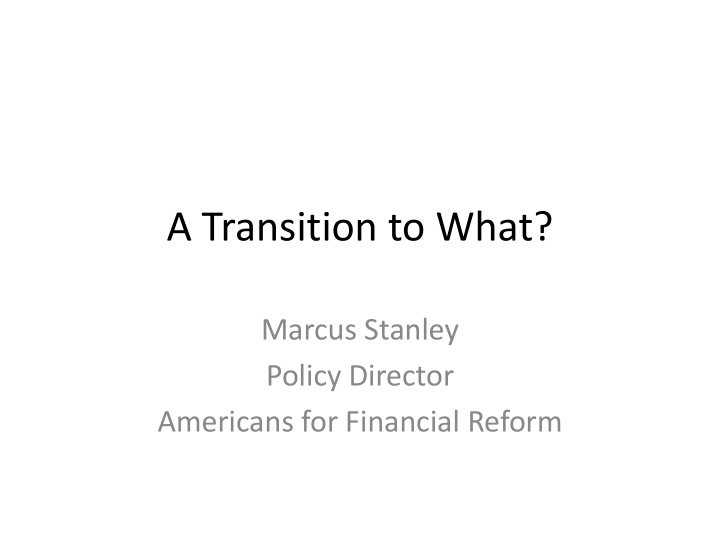



A Transition to What? Marcus Stanley Policy Director Americans for Financial Reform
2000-2008: Radical Changes in Finance • Huge growth in short-term funding: repo and commercial paper. • Short term funding, rising asset markets used to fuel pro-cyclical leverage. • Gross international banking positions over 3.5 times greater in 2008 than 2000. • Notional OTC derivatives grow from 3 times global GDP to 10 times global GDP. • Substantial growth in trading volumes.
Real Economy Impacts • Poor performance in GDP, family income growth. • Phillipon (2012) finds that even the efficiency of credit intermediation has declined. • Cechetti and Kharroubi (2012) find that rapid growth in financial intermediation is correlated with slower productivity growth. • Manifestly huge costs of financial crisis. • Distortionary effects of manipulated asset price bubbles even prior to crisis.
The Response To These Extraordinary Events • Dodd-Frank is radical only in its length. – Enough incremental changes = major shift? • Enormous regulatory discretion. • Systemic reform: ‘Chinese menu’ approach. – Many broad mandates, few details. • Market signals – significant, but will not solve the problem of regulatory direction.
Retail Consumer Space • Combination of: – Interchange fee controls – New credit card protections (CARD Act) – Significant new mortgage origination rules – Consumer Financial Protection Bureau enforcement • Hit to old income models. • But still no direct control of interest rates. • CFPB regulation of non-banks could assist bank competition with non-bank financial services. • Will contribute to systemic reform.
Systemic Reform: Dodd-Frank’s ‘Yes, but’ Approach • Yes to tightening leverage. – But Basel III calls for marginal, not radical change. • Yes to activity limitations. – But Volcker Rule exemptions are significant. • Yes to removing implicit guarantees. – But size of large banks leads to doubts on effectiveness; discretion on specific types of liabilities.
‘Yes, But’ continued • A clearer ‘Yes’ to derivatives reform. – But entire market maintained, major scope for rule weakness. • Yes to oversight of shadow banking. – But through a slow and cumbersome discretionary process, potentially institution-by-institution. • Yes to compensation restrictions, improved risk management. – But lacks clarity, follow through unclear.
Regulatory Fragmentation • U.S. alone: at least five major agencies. – Split between market and institutional regulators. • Complex politics of rulemaking. • New coordination bodies in Treasury have important limits to power, authority. • Serious problems in international coordination – U.S., Europe, London.
Regulatory Ambivalence • Seductive allure of ‘complete credit markets’. • Reviving securitization? Caution around regulating key liquidity sources e.g. repo. • Regulation in the shadow of crisis. – Relationships with mega-banks; economic fragility. • Combination of regulatory fragmentation, ambivalence = central role for ‘stress tests’.
Different Directions • Regulators have broad statutory authority. – but can they harness it to create a coherent and effective vision? • ‘Back to the future’: an updated version of traditional control of the financial markets. • ‘Lighter touch’: incremental limitations on new financial model of last decade. • Questions on both: can ‘lighter touch’ possibly be sufficient? Can deeper reform be achieved?
Significant Market Pressures • Drive for return on equity is a constant. • The economics of size – market power vs. efficiency. • How deep is market shift in risk attitudes? • Scope for expansion of securitization markets both within and outside U.S. • ‘Financial depth’ in BRICs much less than U.S.
Recommend
More recommend